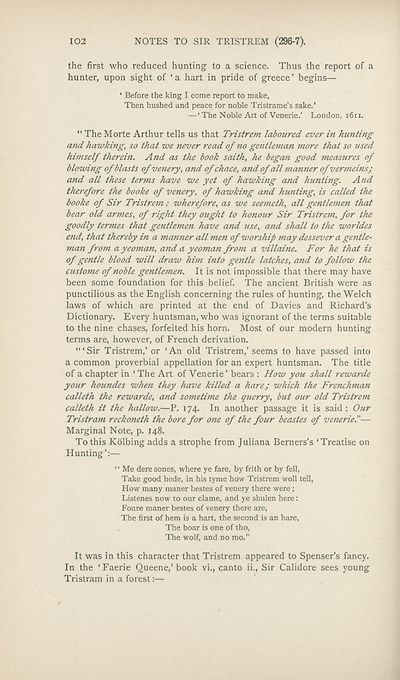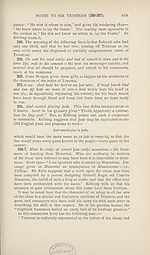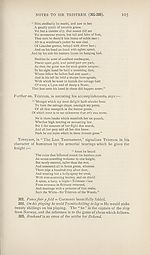Scottish Text Society publications > Old series > Sir Tristrem
(156) Page 102
Download files
Complete book:
Individual page:
Thumbnail gallery: Grid view | List view

102
NOTES TO SIR TRISTREM (296-7).
the first who reduced hunting to a science. Thus the report of a
hunter, upon sight of ‘ a hart in pride of greece ’ begins—
‘ Before the king I come report to make,
Then hushed and peace for noble Tristrame’s sake.’
— ‘ The Noble Art of Venerie.’ London, 1611.
“ The Morte Arthur tells us that Tristrem laboured ever in hunting
and hawking, so that we never read of no gentleman more that so used
hii7iself therein. And as the book saith, he began good measures of
blowing of blasts ofvenery, and ofchace, and of all manner ofvermeins;
and all these terms have we yet of hawking and hunting. And
therefore the booke of venery, of hawking and hunting, is called the
booke of Sir Tristrem: wherefore, as we seemeth, all gentlemen that
bear old armes, of right they ought to honour Sir Tristrem, for the
goodly termes that gentlemen have and use, and shall to the worldes
end, that thereby in a manner all men of worship may dess ever a gentle-
man from a yeoman, and a yeoman from a villaine. For he that is
of gentle blood will draw him into gentle latches, and to follow the
custome of noble gentlemen. It is not impossible that there may have
been some foundation for this belief. The ancient British were as
punctilious as the English concerning the rules of hunting, the Welch
laws of which are printed at the end of Davies and Richard’s
Dictionary. Every huntsman, who was ignorant of the terms suitable
to the nine chases, forfeited his horn. Most of our modern hunting
terms are, however, of French derivation.
“‘Sir Tristrem,’ or ‘An old Tristrem,’ seems to have passed into
a common proverbial appellation for an expert huntsman. The title
of a chapter in ‘The Art of Venerie’ bears : How you shall rewarde
your houndes when they have killed a harej which the Frenchman
calleth the rewarde, and sometime the querry, but our old Tristrem
calleth it the hallow.—P. 174. In another passage it is said : Our
Tristra7n reckoneth the bore for one of the four beastes of venerie."—
Marginal Note, p. 148.
To this Kblbing adds a strophe from Juliana Berners’s ‘Treatise on
Hunting —
“ Me dere sones, where ye fare, by frith or by fell,
Take good hede, in his tyme how Tristrem woll tell,
How many maner bestes of venery there were ;
Listenes now to our clame, and ye shulen here:
Foure maner bestes of venery there are,
The first of hem is a hart, the second is an hare,
The boar is one of tho,
The wolf, and no mo."
It was in this character that Tristrem appeared to Spenser’s fancy.
In the ‘Faerie Queene/book vi., canto ii., Sir Calidore sees young
Tristram in a forest:—
NOTES TO SIR TRISTREM (296-7).
the first who reduced hunting to a science. Thus the report of a
hunter, upon sight of ‘ a hart in pride of greece ’ begins—
‘ Before the king I come report to make,
Then hushed and peace for noble Tristrame’s sake.’
— ‘ The Noble Art of Venerie.’ London, 1611.
“ The Morte Arthur tells us that Tristrem laboured ever in hunting
and hawking, so that we never read of no gentleman more that so used
hii7iself therein. And as the book saith, he began good measures of
blowing of blasts ofvenery, and ofchace, and of all manner ofvermeins;
and all these terms have we yet of hawking and hunting. And
therefore the booke of venery, of hawking and hunting, is called the
booke of Sir Tristrem: wherefore, as we seemeth, all gentlemen that
bear old armes, of right they ought to honour Sir Tristrem, for the
goodly termes that gentlemen have and use, and shall to the worldes
end, that thereby in a manner all men of worship may dess ever a gentle-
man from a yeoman, and a yeoman from a villaine. For he that is
of gentle blood will draw him into gentle latches, and to follow the
custome of noble gentlemen. It is not impossible that there may have
been some foundation for this belief. The ancient British were as
punctilious as the English concerning the rules of hunting, the Welch
laws of which are printed at the end of Davies and Richard’s
Dictionary. Every huntsman, who was ignorant of the terms suitable
to the nine chases, forfeited his horn. Most of our modern hunting
terms are, however, of French derivation.
“‘Sir Tristrem,’ or ‘An old Tristrem,’ seems to have passed into
a common proverbial appellation for an expert huntsman. The title
of a chapter in ‘The Art of Venerie’ bears : How you shall rewarde
your houndes when they have killed a harej which the Frenchman
calleth the rewarde, and sometime the querry, but our old Tristrem
calleth it the hallow.—P. 174. In another passage it is said : Our
Tristra7n reckoneth the bore for one of the four beastes of venerie."—
Marginal Note, p. 148.
To this Kblbing adds a strophe from Juliana Berners’s ‘Treatise on
Hunting —
“ Me dere sones, where ye fare, by frith or by fell,
Take good hede, in his tyme how Tristrem woll tell,
How many maner bestes of venery there were ;
Listenes now to our clame, and ye shulen here:
Foure maner bestes of venery there are,
The first of hem is a hart, the second is an hare,
The boar is one of tho,
The wolf, and no mo."
It was in this character that Tristrem appeared to Spenser’s fancy.
In the ‘Faerie Queene/book vi., canto ii., Sir Calidore sees young
Tristram in a forest:—
Set display mode to: Large image | Zoom image | Transcription
Images and transcriptions on this page, including medium image downloads, may be used under the Creative Commons Attribution 4.0 International Licence unless otherwise stated. ![]()
| Publications by Scottish clubs > Scottish Text Society publications > Old series > Sir Tristrem > (156) Page 102 |
|---|
| Permanent URL | https://digital.nls.uk/106999843 |
|---|
| Description | A collection of over 100 Scottish texts dating from around 1400 to 1700. Most titles are in Scots, and include editions of poetry, drama, and prose by major Scottish writers such as John Barbour, William Dunbar, Gavin Douglas, and George Buchanan. Edited by a key scholarly publisher of Scotland's literary history, and published from the late 19th century onwards by the Scottish Text Society. Available here are STS series 1-3. |
|---|

